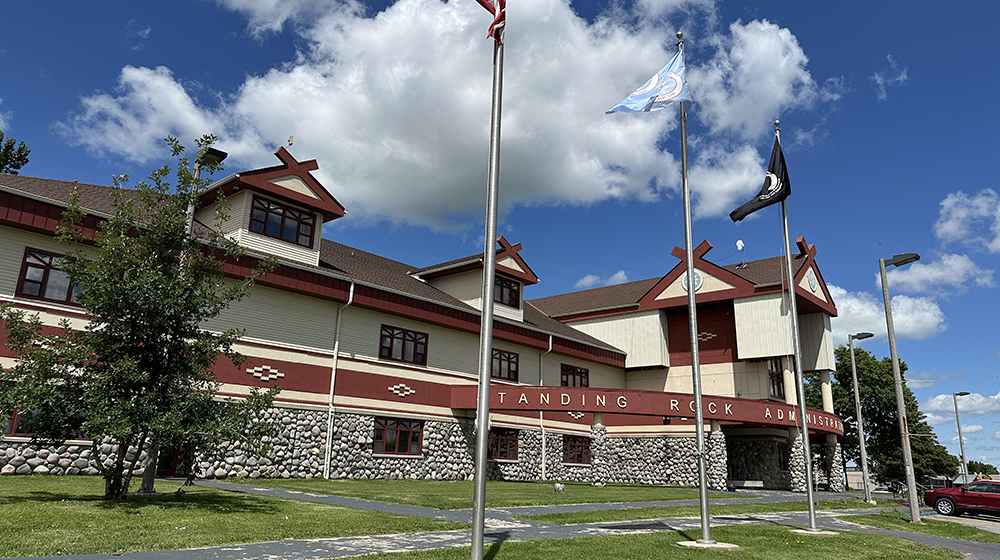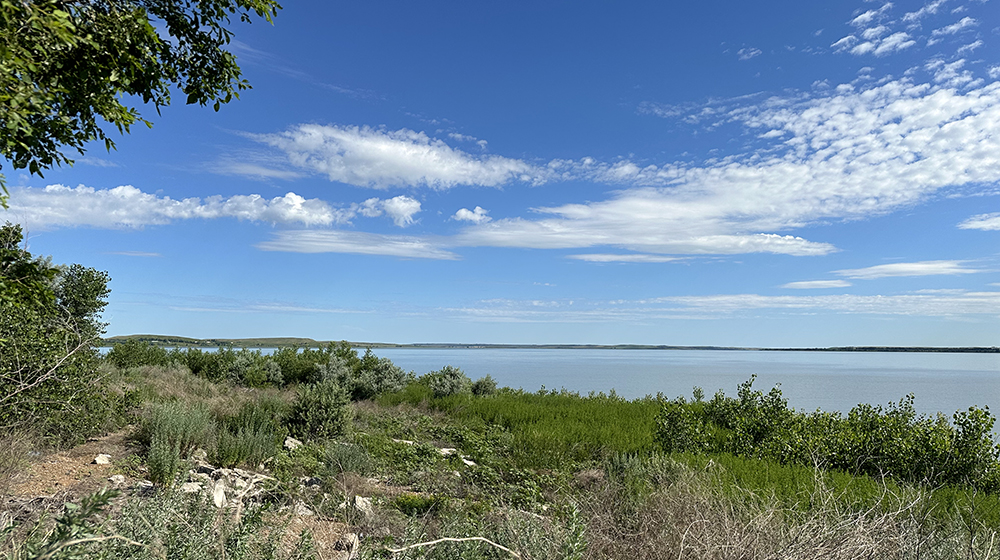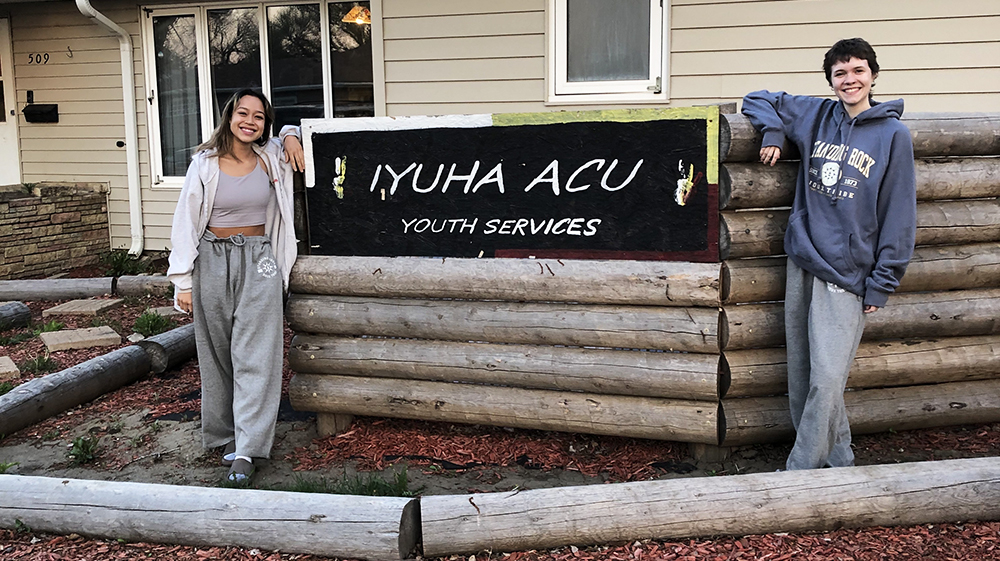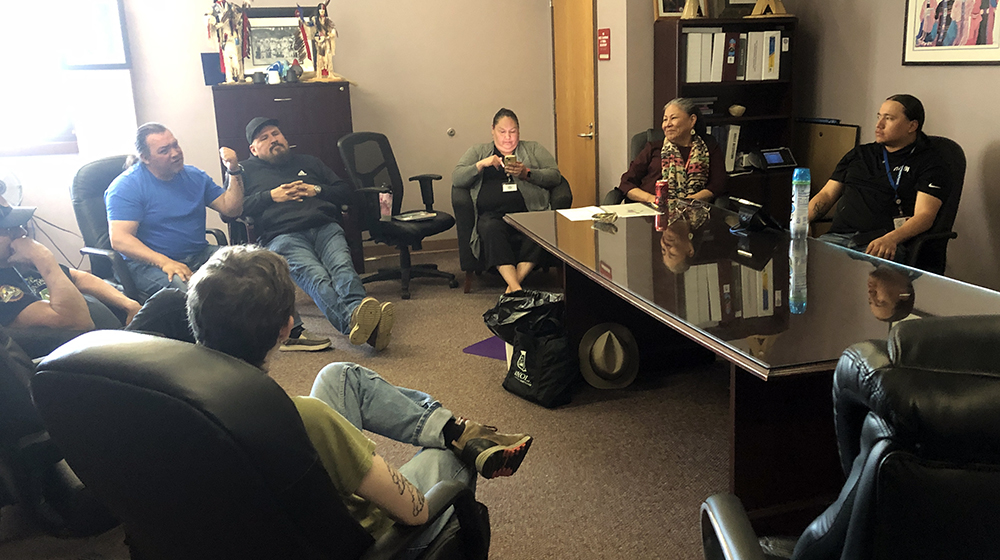Standing Rock 2024

Collaboration for Indigenous Environmental Justice
Collaboration for Indigenous Environmental Justice
Partnership with the Standing Rock Sioux Tribe engages Loyola students in advocating for environmental justice
Loyola University Chicago students and faculty are collaborating with leaders of the Standing Rock Sioux Tribe to advocate for environmental and social justice. The partnership started when Michael Schuck, PhD, introduced a new course on indigenous environmental justice.
Schuck, a professor in the School of Environmental Sustainability and the Department of Theology, designed the engaged learning course to include real-world experiences outside the classroom. He connected with the leaders of the Lakota People's Law Project, the Standing Rock Sioux Tribal Council, and the Great Plains Water Alliance to discuss opportunities for collaboration.

Loyola students met with tribal leaders at the Standing Rock Sioux Tribe's administrative building in Fort Yates, North Dakota.
In October 2023, Schuck led an inaugural student trip to the Standing Rock Sioux Reservation, which spans North and South Dakota. During the visit, students learned about Lakota cultural traditions and heard from tribal leaders and activists about the Lakota people's struggles to protect their lands, waters, and cultural traditions. The students also learned about the tribe's ongoing campaign to shut down the Dakota Access Pipeline (DAPL).
DAPL is a 1,172-mile-long underground pipeline transporting crude oil from northwestern North Dakota to southern Illinois. It runs through land within half a mile of the Standing Rock Reservation and crosses under the Missouri and Mississippi Rivers. The tribe and its allies have opposed the pipeline since Texas-based developer Energy Transfer Partners proposed the project in 2014. Opponents argue that the pipeline desecrates sacred sites, violates treaty rights, damages the environment, and risks contaminating the tribe's primary water source, the Missouri River.
In 2016, tribal leaders took legal action to stop the pipeline, and protesters started to form encampments near planned construction sites. After the Trump administration fast-tracked the project in early 2017, the #NoDAPL movement grew and gained momentum. Environmentalists, Indigenous rights activists, and social justice advocates rallied to support the Lakota people. By the fall of 2017, as many as 4,000 people had joined three encampments along the pipeline's planned route near the North and South Dakota border.
As the camps grew, law enforcement agencies and a private security team hired by the oil company used increasingly aggressive tactics against the protesters. In February 2017, they dispersed the protesters and dismantled the camps using military equipment and riot gear, including rubber bullets, water cannons, and tear gas. The action was traumatic for the Standing Rock community.
"They had guns pointed at our women and our youth and our elders. They had armed guards when our women and elders and children were praying," said Doug Crow Ghost, the chairman of the Great Plains Tribal Water Alliance.

DAPL risks contaminating the Standing Rock Sioux Tribe's primary water source, the Missouri River.
Despite the tribe's opposition, construction proceeded, and the pipeline became operational in June 2017. However, the fight against DAPL continues, with Lakota tribes and their allies working to shut it down. Crow Ghost said that the pipeline creates a constant sense of anxiety among the Standing Rock community.
"The trauma that we have with half a million barrels of oil underneath our water system upstream from our people, our communities, our homes, our way of life, is very damaging and prevalent," he said. It's like going to school in a high rise, and every day you have to the 100th floor, and the fire alarms don't work, and the sprinkler systems don't work, and you know that at any time there could be a fire and you won't know until it's too late. That's what DAPL is to us."
After learning about the fight against DAPL from Crow Ghost and other tribal leaders, environmental studies majors Madison Mede (SES' 24) and Ella Bowles (SES' 25) decided to do additional research on the subject. In May, they returned to the Dakotas with Schuck and shared their work with Crow Ghost, Tribal Chairwoman Janet Alkire, and other members of the tribal council.

Madison Mede (left) and Ella Bowles made (right) a second trip to the Standing Rock Sioux Reservation to present the results of research projects inspired by their first visit.
Mede presented her capstone research project examining the #NoDAPL movement in its historical context. She studied past infrastructure projects that impacted Indigenous peoples and found striking parallels between DAPL protests and Native peoples' resistance to railroad construction in the 1860s.
The Pacific Railway Act of 1862 established federal support for the construction of transcontinental railroads to facilitate westward travel and economic growth. To build the railroads, the federal government violated treaty rights and coerced tribes into giving away thousands of acres of land. The railroads' environmental impacts devastated Native communities.
"The construction of the transcontinental railroad had especially dire consequences for the Native tribes of the Great Plains, forever altering the landscape and eventually leading to the disappearance and instability of wild game, furthering the impact on their ability to maintain their way of life," Mede wrote in her report.
Great Plains tribes attempted to fight the construction of the railways, but federal forces and private interests violently suppressed their resistance and ultimately transformed the American West. In her presentation, Mede discussed how the forceful dispersal of DAPL protesters echoed the violence used to crush Native resistance to the railroads.
"The ideologies at play in 1862 with the Pacific Railway Act are present today," Mede wrote. "From territorial encroachment, displacement, and disruption, treaty violations, to conflict and resistance, these practices have continued throughout history and present themselves in #NoDAPL Protests."

Members of the Standing Rock Sioux Tribal Council and other tribal leaders met with Mede and Bowles to discuss their research.
Tribal leaders said Mede's presentation provided a valuable resource for their advocacy work.
"Putting it in her perspective of an outside person explaining this story by gathering the information and being able to present it the way she did—even to the point of the emotional impact for our people—I think that would have a tremendous impact on giving listeners a better idea of what has happened and things that have hampered us," said Harold Tiger, emergency management director for the Standing Rock Sioux Tribe.
During the meeting with Tribal leaders, Mede and Bowles also shared the results of their remote sensing project titled "Vegetative and Water Analysis of Standing Rock Reservation." The students used satellite data and geographic information systems (GIS) to examine the entire reservation and compare vegetation cover and water levels before and after pipeline construction. While they did not observe significant changes in the vegetation, the data revealed changes in water levels, which the students attributed to the Army Corps of Engineers' management of dams and reservoirs.
Crow Ghost said that while this analysis was preliminary, additional remote sensing studies would be valuable in determining the longer-term impacts of DAPL and the Army Corps' water management practices. He noted that the students' research provided a meaningful service, and he looks forward to continuing the tribe's partnership with the Loyola community.
"I think the collaboration with the university is really going to open the eyes of the world again," he said.
Mede, who graduated in May, hopes to continue her work with the tribe and ultimately pursue a career in environmental law.
"My trips to Standing Rock have provided me with countless valuable lessons and unique experiences," she said. "The knowledge I gained through exposure and listening to the stories from pillars of the community resonated with me. Not only was I academically educated, but I have been spiritually educated. I have a stronger connection to nature, a deeper understanding of its intrinsic value, and a stronger resolve to continue my path of environmental justice."
Bowles said her time at Standing Rock sparked a deep interest in environmental justice, and she plans to make it a central focus in her education and throughout her career.

Schuck (second from the right) led a third student trip to Standing Rock in early October, 2024. Students met with tribal leaders including Standing Rock Game, Fish, and Wildife Director Jeff Kelly (right).
Schuck is teaching the Indigenous environmental justice course again in the fall 2024 semester and just returned from a third student trip to the Standing Rock Sioux Reservation. Student research from this trip will include the role of Lakota song and drumming in action for environmental justice and the trauma impact of the tribe’s ongoing struggle against the Dakota Access Pipeline. Through the trips and research, Schuck aims to keep building partnerships with the tribe, create more student allies for Native American communities struggling for environmental and social justice, and help transform the lives of Loyola University students.
More than 200 Loyola students, faculty, and staff members heard directly from Doug Crow Ghost and other Indigenous leaders on October 14, 2024, when Crow Ghost traveled to campus to participate in a panel discussion for Indigenous Peoples' Day.
Story by Stephanie Folk
October 15, 2024
In October 2023, Schuck led an inaugural student trip to the Standing Rock Sioux Reservation, which spans North and South Dakota. During the visit, students learned about Lakota cultural traditions and heard from tribal leaders and activists about the Lakota people's struggles to protect their lands, waters, and cultural traditions. The students also learned about the tribe's ongoing campaign to shut down the Dakota Access Pipeline (DAPL).
DAPL is a 1,172-mile-long underground pipeline transporting crude oil from northwestern North Dakota to southern Illinois. It runs through land within half a mile of the Standing Rock Reservation and crosses under the Missouri and Mississippi Rivers. The tribe and its allies have opposed the pipeline since Texas-based developer Energy Transfer Partners proposed the project in 2014. Opponents argue that the pipeline desecrates sacred sites, violates treaty rights, damages the environment, and risks contaminating the tribe's primary water source, the Missouri River.
In 2016, tribal leaders took legal action to stop the pipeline, and protesters started to form encampments near planned construction sites. After the Trump administration fast-tracked the project in early 2017, the #NoDAPL movement grew and gained momentum. Environmentalists, Indigenous rights activists, and social justice advocates rallied to support the Lakota people. By the fall of 2017, as many as 4,000 people had joined three encampments along the pipeline's planned route near the North and South Dakota border.
As the camps grew, law enforcement agencies and a private security team hired by the oil company used increasingly aggressive tactics against the protesters. In February 2017, they dispersed the protesters and dismantled the camps using military equipment and riot gear, including rubber bullets, water cannons, and tear gas. The action was traumatic for the Standing Rock community.
"They had guns pointed at our women and our youth and our elders. They had armed guards when our women and elders and children were praying," said Doug Crow Ghost, the chairman of the Great Plains Tribal Water Alliance.
Despite the tribe's opposition, construction proceeded, and the pipeline became operational in June 2017. However, the fight against DAPL continues, with Lakota tribes and their allies working to shut it down. Crow Ghost said that the pipeline creates a constant sense of anxiety among the Standing Rock community.
"The trauma that we have with half a million barrels of oil underneath our water system upstream from our people, our communities, our homes, our way of life, is very damaging and prevalent," he said. It's like going to school in a high rise, and every day you have to the 100th floor, and the fire alarms don't work, and the sprinkler systems don't work, and you know that at any time there could be a fire and you won't know until it's too late. That's what DAPL is to us."
After learning about the fight against DAPL from Crow Ghost and other tribal leaders, environmental studies majors Madison Mede (SES' 24) and Ella Bowles (SES' 25) decided to do additional research on the subject. In May, they returned to the Dakotas with Schuck and shared their work with Crow Ghost, Tribal Chairwoman Janet Alkire, and other members of the tribal council.
Mede presented her capstone research project examining the #NoDAPL movement in its historical context. She studied past infrastructure projects that impacted Indigenous peoples and found striking parallels between DAPL protests and Native peoples' resistance to railroad construction in the 1860s.
The Pacific Railway Act of 1862 established federal support for the construction of transcontinental railroads to facilitate westward travel and economic growth. To build the railroads, the federal government violated treaty rights and coerced tribes into giving away thousands of acres of land. The railroads' environmental impacts devastated Native communities.
"The construction of the transcontinental railroad had especially dire consequences for the Native tribes of the Great Plains, forever altering the landscape and eventually leading to the disappearance and instability of wild game, furthering the impact on their ability to maintain their way of life," Mede wrote in her report.
Great Plains tribes attempted to fight the construction of the railways, but federal forces and private interests violently suppressed their resistance and ultimately transformed the American West. In her presentation, Mede discussed how the forceful dispersal of DAPL protesters echoed the violence used to crush Native resistance to the railroads.
"The ideologies at play in 1862 with the Pacific Railway Act are present today," Mede wrote. "From territorial encroachment, displacement, and disruption, treaty violations, to conflict and resistance, these practices have continued throughout history and present themselves in #NoDAPL Protests."
Tribal leaders said Mede's presentation provided a valuable resource for their advocacy work.
"Putting it in her perspective of an outside person explaining this story by gathering the information and being able to present it the way she did—even to the point of the emotional impact for our people—I think that would have a tremendous impact on giving listeners a better idea of what has happened and things that have hampered us," said Harold Tiger, emergency management director for the Standing Rock Sioux Tribe.
During the meeting with Tribal leaders, Mede and Bowles also shared the results of their remote sensing project titled "Vegetative and Water Analysis of Standing Rock Reservation." The students used satellite data and geographic information systems (GIS) to examine the entire reservation and compare vegetation cover and water levels before and after pipeline construction. While they did not observe significant changes in the vegetation, the data revealed changes in water levels, which the students attributed to the Army Corps of Engineers' management of dams and reservoirs.
Crow Ghost said that while this analysis was preliminary, additional remote sensing studies would be valuable in determining the longer-term impacts of DAPL and the Army Corps' water management practices. He noted that the students' research provided a meaningful service, and he looks forward to continuing the tribe's partnership with the Loyola community.
"I think the collaboration with the university is really going to open the eyes of the world again," he said.
Mede, who graduated in May, hopes to continue her work with the tribe and ultimately pursue a career in environmental law.
"My trips to Standing Rock have provided me with countless valuable lessons and unique experiences," she said. "The knowledge I gained through exposure and listening to the stories from pillars of the community resonated with me. Not only was I academically educated, but I have been spiritually educated. I have a stronger connection to nature, a deeper understanding of its intrinsic value, and a stronger resolve to continue my path of environmental justice."
Bowles said her time at Standing Rock sparked a deep interest in environmental justice, and she plans to make it a central focus in her education and throughout her career.
Schuck is teaching the Indigenous environmental justice course again in the fall 2024 semester and just returned from a third student trip to the Standing Rock Sioux Reservation. Student research from this trip will include the role of Lakota song and drumming in action for environmental justice and the trauma impact of the tribe’s ongoing struggle against the Dakota Access Pipeline. Through the trips and research, Schuck aims to keep building partnerships with the tribe, create more student allies for Native American communities struggling for environmental and social justice, and help transform the lives of Loyola University students.
More than 200 Loyola students, faculty, and staff members heard directly from Doug Crow Ghost and other Indigenous leaders on October 14, 2024, when Crow Ghost traveled to campus to participate in a panel discussion for Indigenous Peoples' Day.
Story by Stephanie Folk
October 15, 2024
